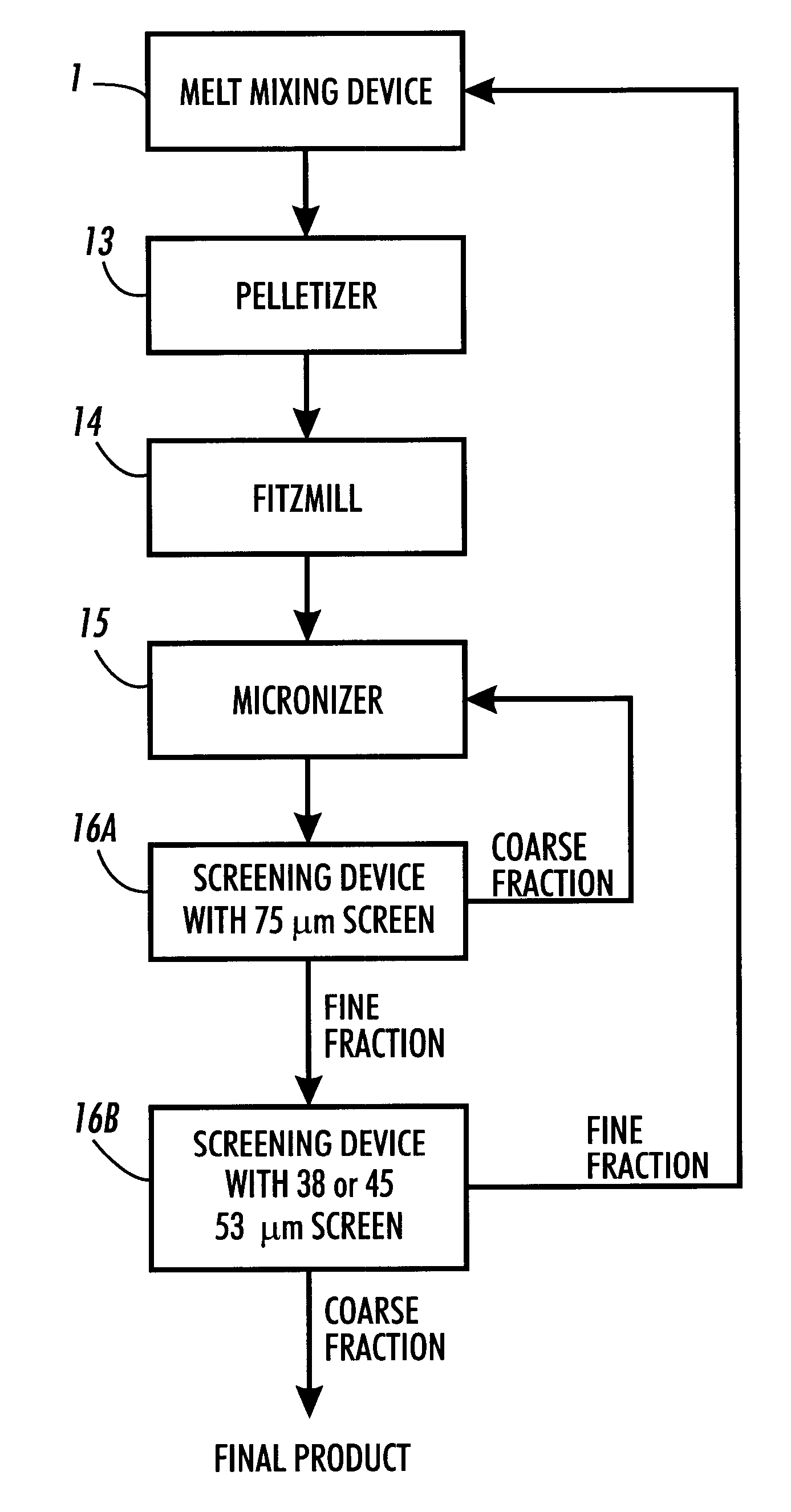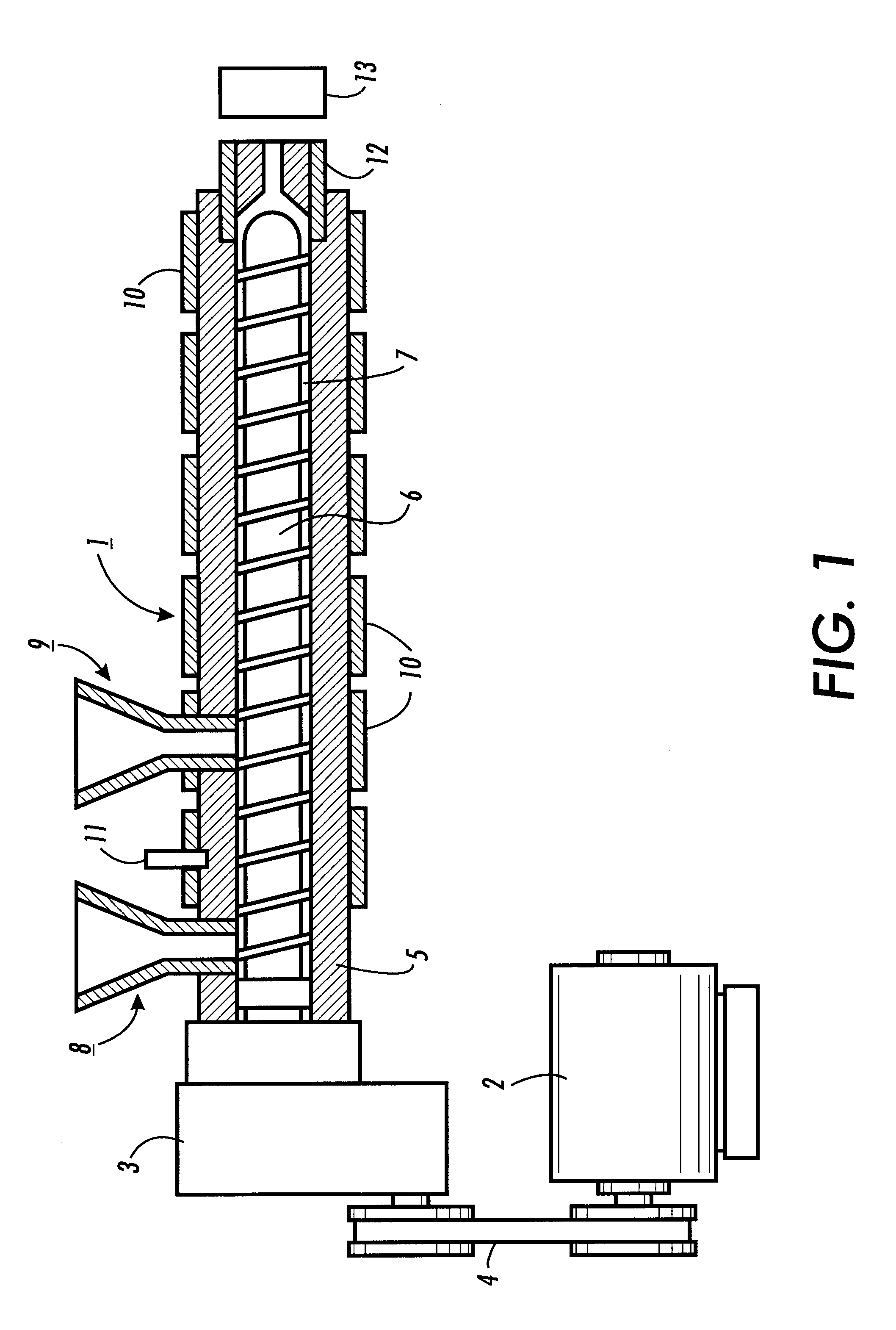Carrier pelletizing processes
a technology of carrier pellets and xerographic films, applied in the field of electrostatic process, can solve the problems of triboelectric charging characteristics, reducing the resolution of images, and reducing the number of coatings
- Summary
- Abstract
- Description
- Claims
- Application Information
AI Technical Summary
Benefits of technology
Problems solved by technology
Method used
Image
Examples
example iv
Four 500 gram samples of the fitzmilled product of Comparative Example II are jetted in an 8 inch Sturtevant micronizer according to a 2.times.2 full factorial matrix of feed rates of fitzmilled material and air pressures as denoted in Table II. The jetted material in each situation is screened through a 75 micron screen to remove coarse particles and the fines fraction is retained as product. The particle size distribution of each product (carrier) is measured with a Coulter Counter, and the product yield which is the weight fraction of product between 25 and 75 microns calculated from the particle size distribution is given in Table II.
As illustrated in Table II, there is a window of operation that provides suitable yield of jetted material with particle sizes in the range of from about 25 to about 75 microns. In the present Example, the highest yield of product is obtained by utilizing a feed rate of fitzmilled material of 5.0 pounds per hour and an air pressure of 65 pounds per ...
example v
A 2 kilogram sample of the extruded product of Example I is ground in a Model J Fitzmill utilizing a 850 micron screen and running with a rotor speed of about 1,750 revolutions per minute. A 1,000 gram sample of this fitzmilled product is jetted in an 8 inch Sturtevant micronizer at a feed rate of about 5.0 pounds per hour and air pressure of 65 pounds per square inch. The jetted material is then screened first through a 75 micron screen and then through a 38 micron screen utilizing an Alpine Model A200LS air jet sieve. The course fraction from the 38 micron screen with a particle size greater than about 38 microns has a weight of about 460 grams and is retained as Product A; the fines fraction having particle size less than 38 microns has a weight of 480 grams and is retained as intermediate Product B for use in Example VI. Product A is microsynthetic carrier comprised of about 38 percent by weight styrene n-butyl methacrylate copolymer, 49 percent by weight of magnetite, and about...
example vi
Intermediate Product B of Example V which is the fines fraction of the screened carrier material less than 38 microns in size is classified twice in a Donaldson Model A12 Acucut air classifier with a rotor speed of 1,000 revolutions per minute. The resultant product with a weight of about 240 grams is a microsynthetic carrier comprised of about 49 percent by weight of magnetite, about 14 percent of carbon black and about 37 percent by weight styrene n-butyl methacrylate copolymer as measured by thermal gravimetric analysis, and has a volume average diameter of about 25 microns and GSD of about 1.37 as measured with a Coulter Counter.
Thereafter, the above prepared carrier is permanently magnetized at 8,500 gauss, and a developer mixture is prepared by mixing 10 grams of magnetized carrier and 1.6 grams of toner of Example V. The triboelectric charge on the carrier is measured as about 9 microcoulombs / g and the conductivity is about 2.times.10.sup.-10 mho / cm. Therefore, the carrier pa...
PUM
| Property | Measurement | Unit |
|---|---|---|
| size | aaaaa | aaaaa |
| temperature | aaaaa | aaaaa |
| temperature | aaaaa | aaaaa |
Abstract
Description
Claims
Application Information
 Login to View More
Login to View More - R&D
- Intellectual Property
- Life Sciences
- Materials
- Tech Scout
- Unparalleled Data Quality
- Higher Quality Content
- 60% Fewer Hallucinations
Browse by: Latest US Patents, China's latest patents, Technical Efficacy Thesaurus, Application Domain, Technology Topic, Popular Technical Reports.
© 2025 PatSnap. All rights reserved.Legal|Privacy policy|Modern Slavery Act Transparency Statement|Sitemap|About US| Contact US: help@patsnap.com



